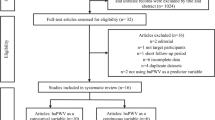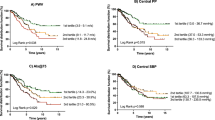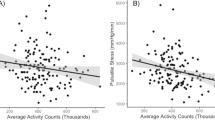Abstract
Aortic stiffness measured by aorta-iliac or carotid-femoral pulse wave velocity (PWV) predicts all-cause and cardiovascular mortality. Brachial-ankle PWV (baPWV) has been developed as a more convenient assessment of arterial stiffness. However, the problem with clinical use of baPWV is that the index itself is closely dependent on blood pressure. Recently, a new method, termed the cardio-ankle vascular index (CAVI), has been proposed in Japan to overcome the disadvantages associated with measuring PWV. However, its clinical usefulness has not yet been fully clarified. In the present study, we compared the usefulness of CAVI with that of ultrasound for evaluating atherosclerosis in patients with essential hypertension. CAVI was measured in 70 hypertensive patients. The intima-media thickness (IMT), cross-sectional distensibility coefficient (CSDC), stiffness parameter β, and mean diastolic (Vd) and systolic (Vs) flow velocities were evaluated by carotid ultrasound. The Vd/Vs ratio, an index of peripheral arterial resistance, was also calculated. CAVI was positively correlated with IMT (r=0.360, p=0.0022) and stiffness β (r=0.270, p=0.0239) and negatively correlated with Vd/Vs (r=−0.471, p<0.0001) and CSDC (r=−0.315, p=0.0079). Stepwise regression analysis revealed that age (r=0.475, p<0.0001) and pulse pressure (r=0.492, r<0.0001) were independent determinants of CAVI. These results suggest that CAVI is a useful clinical marker for evaluating atherosclerosis and arteriolosclerosis in patients with essential hypertension.
Similar content being viewed by others
Article PDF
References
Blacher J, Asmar R, Djane S, London GM, Safar ME : Aortic pulse wave velocity as a marker of cardiovascular risk in hypertensive patients. Hypertension 1999; 33; 1111–1117.
Laurent S, Boutouyrie P, Asmar R, et al: Aortic stiffness is an independent predictor of all-cause and cardiovascular mortality in hypertensive patients. Hypertension 2001; 37: 1236–1241.
Mattace-Raso FU, van der Cammen TJ, Hofman A, et al: Arterial stiffness and risk of coronary heart disease and stroke. The Rotterdam Study. Circulation 2006; 113: 657–663.
Asmar R, Topouchian J, Pannier B, Benetos A, Safar M : Pulse wave velocity as endpoint in large-scale intervention trial: the Complior study. Scientific Quality Control, Coordination and Investigation Committees of the Complior study. J Hypertens 2001; 19: 813–818.
Kubo T, Miyata M, Minagoe S, Setoyama S, Maruyama I, Tei C : A simple oscillometric technique for determining new indices of arterial distensibility. Hypertens Res 2002; 25: 351–358.
Yamashina A, Tomiyama H, Takeda K, et al: Validity, reproducibility, and clinical significance of noninvasive brachial-ankle pulse wave velocity measurement. Hypertens Res 2002; 25: 359–364.
Yamashina A, Tomiyama H, Arai T, et al: Brachial-ankle pulse wave velocity as a marker of atherosclerotic vascular damage and cardiovascular risk. Hypertens Res 2003; 26: 615–622.
Munakata M, Ito N, Nunokawa T, Yoshinaga K : Utility of automated brachial ankle pulse wave velocity measurements in hypertensive patients. Am J Hypertens 2003; 16: 653–657.
Imanishi R, Seto S, Toda G, et al: High brachial-ankle pulse wave velocity is an independent predictor of the presence of coronary artery disease in men. Hypertens Res 2004; 27: 71–78.
Matsui Y, Kario K, Ishikawa J, Eguchi K, Hoshide S, Shimada K : Reproducibility of arterial stiffness indices (pulse wave velocity and augmentation index) simultaneously assessed by automated pulse wave analysis and their associated risk factors in essential hypertensive patients. Hypertens Res 2004; 27: 851–857.
Yambe T, Yoshizawa M, Saijo Y, et al: Brachio-ankle pulse wave velocity and cardio-ankle vascular index (CAVI). Biomed Pharmacother 2004; 58: S95–S98.
Yambe T, Meng X, Hou X, et al: Cardio-ankle vascular index (CAVI) for the monitoring of the atherosclerosis after heart transplantation. Biomed Pharmacother 2005; 59: S177–S179.
Shirai K, Utino J, Otsuka K, Takata M : A novel blood pressure–independent arterial wall stiffness parameter; cardio-ankle vascular index (CAVI). J Atheroscler Thromb 2006; 13: 101–107.
Yambe M, Tomiyama H, Hirayama Y, et al: Arterial stiffening as a possible risk factor for both atherosclerosis and diastolic heart failure. Hypertens Res 2004; 27: 625–631.
Handa N, Matsumoto M, Maeda H, et al: Ultrasonic evaluation of early carotid atherosclerosis. Stroke 1990; 21: 1567–1572.
Pignoli P, Tremoli E, Poli A, Oreste P, Paoletti R : Intimal plus medial thickness of the arterial wall: a direct measurement with ultrasound imaging. Circulation 1986; 74: 1399–1406.
Jiang YN, Kohara K, Hiwada K : Alteration of carotid circulation in essential hypertensive patients with left ventricular hypertrophy. J Hum Hypertens 1998; 12: 173–179.
Okura T, Watanabe S, Miyoshi K, Fukuoka T, Higaki J : Intrarenal and carotid hemodynamics in patients with essential hypertension. Am J Hypertens 2004; 17: 240–244.
Jiang Y, Kohara K, Hiwada K : Low wall shear stress in carotid arteries in subjects with left ventricular hypertrophy. Am J Hypertens 2000; 13: 892–898.
Wakabayashi I, Masuda H : Effects of age on the relationship between cardio-ankle vascular index and atherosclerotic progression in patients with type 2 diabetes mellitus. Jpn J Geriat 2006; 43: 217–221.
Taniwaki H, Kawagishi T, Emoto M, et al: Correlation between the intima-media thickness of the carotid artery and aortic pulse-wave velocity in patients with type 2 diabetes. Vessel wall properties in type 2 diabetes. Diabetes Care 1999; 22: 1851–1857.
van Popele NM, Grobbee DE, Bots ML, et al: Association between arterial stiffness and atherosclerosis. The Rotterdam Study. Stroke 2001; 32: 454–460.
Paini A, Boutouyrie P, Calvet D, Tropeano A-I, Laloux B, Laurent S : Carotid and aortic stiffness: determinants of discrepancies. Hypertension 2006; 47: 371–376.
Tamaki T, Sawada K, Hayashi S, Node Y, Teramoto A : Carotid atherosclerosis and arterial peripheral pulse wave velocity in cerebral thrombosis. J Clin Neurosci 2006; 13: 45–49.
Makita S, Nakamura M, Hiramori K : The association of C-reactive protein levels with carotid intima-media complex thickness and plaque formation in the general population. Stroke 2005; 36: 2138–2142.
Tong PC, Ho CS, Yeung VT, et al: Association of testosterone, insulin-like growth factor-I, and C-reactive protein with metabolic syndrome in Chinese middle-aged men with a family history of type 2 diabetes. J Clin Endocrinol Metab 2005; 90: 6418–6423.
Targher G, Bertolini L, Scala L, Zoppini G, Zenari L, Falezza G : Non-alcoholic hepatic steatosis and its relation to increased plasma biomarkers of inflammation and endothelial dysfunction in non-diabetic men. Role of visceral adipose tissue. Diabet Med 2005; 22: 1354–1358.
Masugata H, Senda S, Yoshikawa K, et al: Relationships between echocardiographic findings, pulse wave velocity, and carotid atherosclerosis in type 2 diabetic patients. Hypertens Res 2005; 28: 965–971.
Kurata M, Okura T, Watanabe S, Higaki J : Association between carotid hemodynamics and asymptomatic white and gray matter lesions in patients with essential hypertension. Hypertens Res 2005; 28: 797–803.
Tsubakimoto A, Saito I, Mannami T, et al: Impact of metabolic syndrome on brachial-ankle pulse wave velocity in Japanese. Hypertens Res 2006; 29: 29–37.
Dart AM, Gatzka CD, Kingwell BA, et al: Brachial blood pressure but not carotid arterial waveforms predict cardiovascular events in elderly female hypertensives. Hypertension 2006; 47: 785–790.
Author information
Authors and Affiliations
Corresponding author
Rights and permissions
About this article
Cite this article
Okura, T., Watanabe, S., Kurata, M. et al. Relationship between Cardio-Ankle Vascular Index (CAVI) and Carotid Atherosclerosis in Patients with Essential Hypertension. Hypertens Res 30, 335–340 (2007). https://doi.org/10.1291/hypres.30.335
Received:
Accepted:
Issue date:
DOI: https://doi.org/10.1291/hypres.30.335
Keywords
This article is cited by
-
CAVI (Cardio-Ankle Vascular Index) as an independent predictor of hypertensive response to exercise
BMC Cardiovascular Disorders (2024)
-
An exploratory cross-sectional study of subclinical vascular damage in patients with polymyalgia rheumatica
Scientific Reports (2020)
-
Cardio-ankle vascular index is linked to deranged metabolic status, especially high HbA1c and monocyte-chemoattractant-1 protein, in predialysis chronic kidney disease
International Urology and Nephrology (2020)
-
Pulse-Wave-Pattern Classification with a Convolutional Neural Network
Scientific Reports (2019)
-
Serum adipocyte fatty acid-binding protein level is associated with arterial stiffness quantified with cardio-ankle vascular index in kidney transplant patients
Clinical and Experimental Nephrology (2018)



